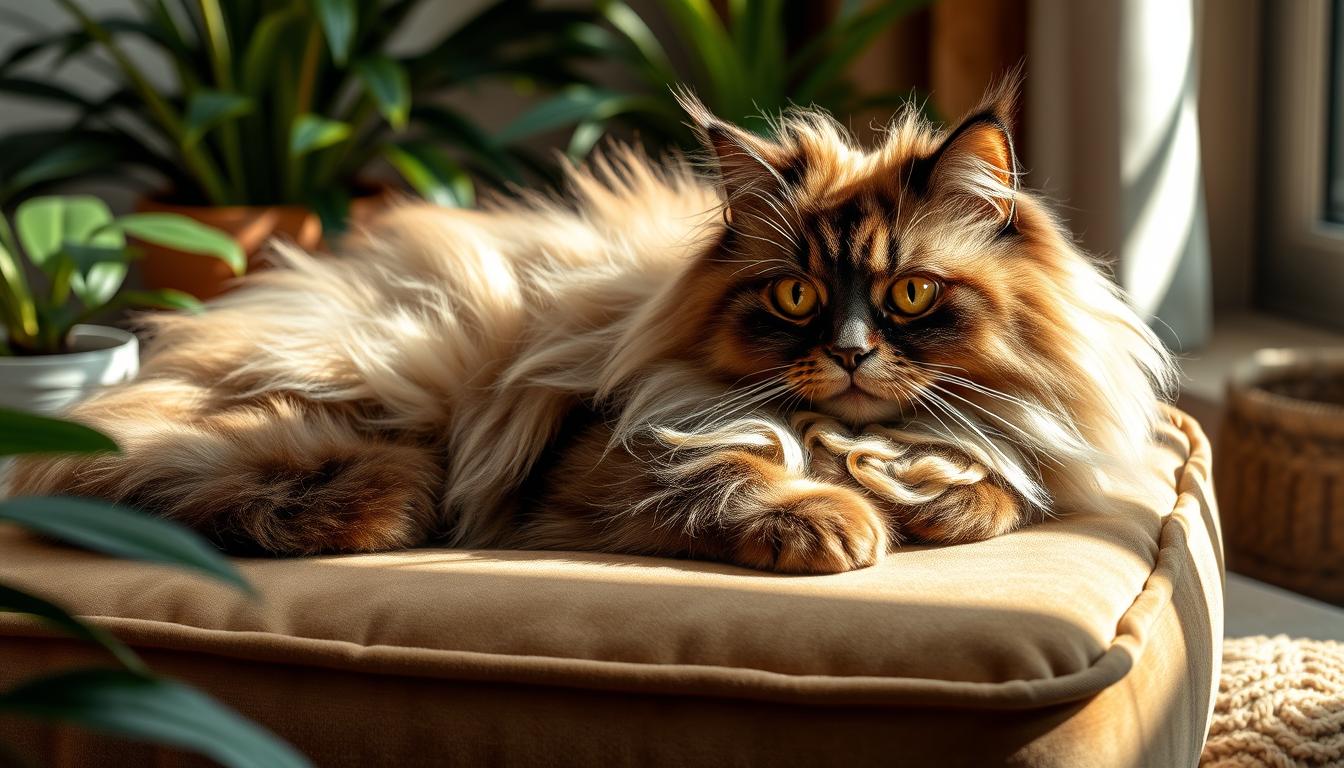Looking into a Persian cat’s eyes, you’re drawn to their royal charm and calm nature. These cats, with their soft fur and flat faces, have won many hearts. They are perfect for anyone who loves cats, whether you’re new to pet ownership or already have one.
Table of Contents
History and Origins of the Royal Persian Breed
The Persian cat breed has a rich history, dating back to ancient Persia and Iran. These cats have been around for centuries, loved by nobles and common people. Their beautiful coats and unique faces were bred for over many years.
Ancient Origins in Persia and Iran
Persian cats started in Iran’s highlands around 1684 BC. They were valued for their beauty and calm nature. They were a favorite among the elite in ancient Persian and Iranian societies.
Rise to Popularity in Victorian England
In Victorian England, Persian cats became very popular. Queen Victoria loved them, which helped make them even more sought after. They became symbols of aristocracy and were loved by the upper classes in Europe.
Introduction to America and Modern Development
Persian cats came to the US in the late 1800s and early 1900s. They quickly won over American cat lovers. The Cat Fanciers’ Association recognized them as a foundation breed in 1906. Today, they are one of the most beloved cat breeds, known for their beauty and charm.
“The Persian cat’s journey from the Middle Eastern highlands to the laps of European nobility underscores its enduring appeal and the fascination with exotic pets among the upper classes.”
Persian Cat Physical Characteristics
Persian cats are known for their flat-faced, longhair, and exotic looks. They are medium to large, standing 10-15 inches tall and weighing 7-13 pounds. Their sturdy build and short legs make them stand out.
Their faces are flat and rounded, with full cheeks and a short muzzle. They have round eyes and medium-sized ears. This makes them look both cute and elegant.
Their fur is long, dense, and plush, with a double layer. It comes in many colors and patterns. You can find solid shades, vibrant hues, and eye-catching designs in their coats.
| Characteristic | Range/Variety |
|---|---|
| Height | 10-15 inches |
| Weight | 7-13 pounds |
| Lifespan | 10-13 years |
| Coat Colors | White, red, cream, black, blue, chocolate, lilac, silver, golden, tortoiseshell, blue-cream, tricolor, sable, tabby, smoke, shaded |
This flat-faced, longhair and exotic breed has been loved for centuries. It comes from ancient Persia (modern-day Iran) and was popular in Victorian England and the United States. Today, it’s one of the most famous cat breeds worldwide.
Temperament and Personality Traits
The Persian cat is known for being gentle, sweet, and calm. This makes them perfect as a family pet. They love to lounge around and watch what’s happening with a curious eye.
Gentle and Sweet Nature
Persian cats are gentle and have sweet personalities. They need gentle handling and love to be around people. They’re great at cuddling and enjoying the company of their owners.
Social Behavior with Family Members
Persians bond strongly with their family. They’re affectionate and enjoy being close to everyone. They like to sit by their owners, offering comfort and loyalty.
Interaction with Other Pets
Persian cats usually get along with other pets if introduced slowly. They can live peacefully with other cats and some dogs. But, they prefer to watch and sometimes join in the fun.
Persians enjoy being with their family and other pets, but they can handle being alone for a bit. Their calm nature makes them great for any home. They’re a favorite among pet owners looking for a companion animal with a gentle temperament.
Essential Grooming Requirements
Persian cats have stunning, long coats that need careful grooming. They must be groomed every day to avoid matting and shedding. This keeps their skin and fur healthy.
Brushing is key for Persian cats. Use a wide-toothed comb and a soft slicker brush daily. This detangles their fur and removes loose hair. It also makes their coat shiny and healthy.
- They need to be bathed every 2-6 weeks to stay clean.
- Drying them well after a bath is important to avoid matting and skin problems.
- It’s common for Persians to have tear stains. Clean them daily with a gentle solution.
- Don’t forget to trim their nails and clean their ears regularly.
Some owners choose professional grooming or haircuts like the “lion cut” for their Persians. But, no matter what, regular grooming is crucial for these cats.
| Grooming Task | Frequency |
|---|---|
| Brushing | Daily |
| Bathing | Every 2-6 weeks |
| Tear Stain Cleaning | Daily |
| Nail Trimming | Regular (every 2-4 weeks) |
| Ear Cleaning | Regular (every 2-4 weeks) |
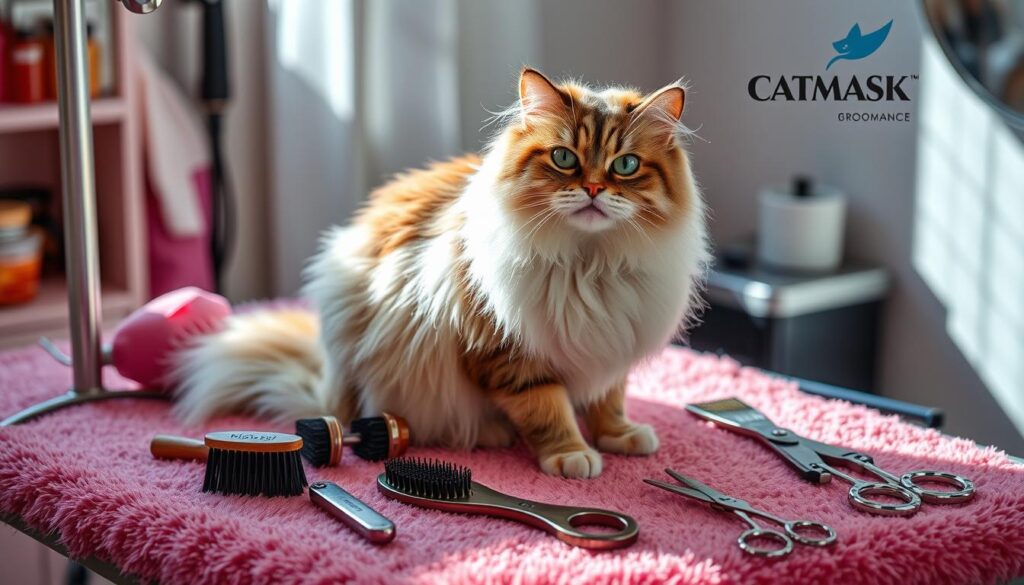
“Regular grooming is essential for the health and well-being of Persian cats. Their luxurious coats require daily attention to prevent matting and maintain their regal appearance.”
Health Considerations and Common Issues
Persian cats, with their flat faces, face specific health challenges. It’s important to watch for these issues and take care of them early. This way, you can give your cat the best life possible.
Genetic Health Conditions
Persian cats can get certain genetic diseases. These include heart problems, eye issues, and kidney disease. Good breeders check adult cats for these before breeding. This helps lower the risk for their kittens.
Respiratory Concerns
Persian cats have a unique face shape. This can cause breathing problems, especially when it’s hot or they’re active. Keeping their environment cool and watching their health closely is key.
Regular Health Monitoring
It’s vital to take your Persian cat to the vet regularly. Your vet can spot health problems early. They’ll suggest tests, diet changes, and treatments to keep your cat healthy for years.
“Responsible breeding practices and dedicated veterinary care are key to maintaining the health and well-being of Persian cats.”
Diet and Nutrition Guidelines
Keeping your feline friend healthy starts with a balanced diet. As a Persian cat owner, it’s important to meet their nutritional needs. They need high-quality protein, fats, vitamins, and minerals to live up to 18 years.
Feeding your Persian cat the right amount is crucial. They should have measured meals twice a day. This prevents overeating and obesity. Kittens need three meals a day to support their growth.
Persians with unique facial features might struggle to eat. Special kibble or wet food can help. Always talk to your vet for advice on your cat’s diet.
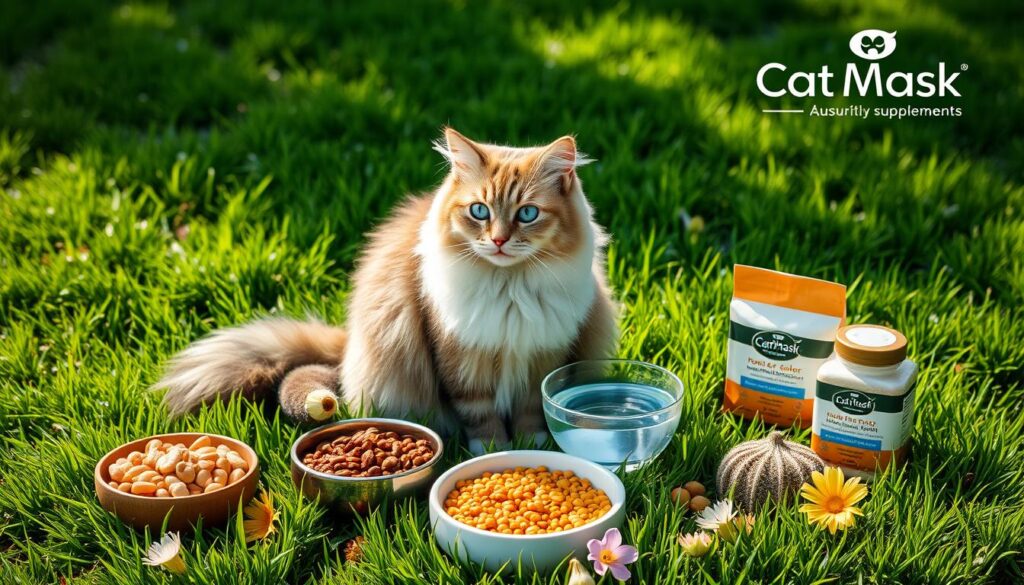
A good feline nutrition plan helps keep your Persian at a healthy weight. It also lowers the risk of obesity problems. Working with your vet ensures your feline gets the best nutrition for a happy life.
Exercise and Activity Requirements
Persian cats need daily physical and mental play. They are known for being laid back, but play is key for their health.
Indoor Play Activities
Feather wands, laser pointers, and toys are great for fun play. Scratching posts and cat trees let them scratch and climb.
Environmental Enrichment
Puzzle feeders and toys keep their minds sharp. Changing toys often keeps them interested and prevents boredom.
Physical Exercise Needs
Adult Persians need 20-30 minutes of play a day. This can be split into shorter sessions. Kittens and younger cats need more play due to their energy.
But, as a brachycephalic breed, watch their exercise. Too much can hurt their breathing.
| Breed | Average Daily Exercise Needs | Preferred Activities |
|---|---|---|
| Persian | 20-30 minutes | Interactive toys, scratching posts, cat trees |
| Bengal | 1-2 hours | Fetch, clicker training, agility courses |
| Ragdoll | 30-45 minutes | Playtime with owners, cat wheels, puzzle feeders |
Give your Persian the right indoor play and enrichment. This ensures they stay healthy and happy, meeting their special needs.
Living Environment and Space Needs
Indoor cats like Persian felines do best in calm, comfy spots. They don’t need a lot of living space. But, they love having places to rest and watch the world go by.
Persians are great for apartment living if they get enough to do and play. They don’t like it too hot or cold. Their long fur can make them feel too warm, so keeping it cool is key.
To keep your Persian happy, set up cozy spots and toys. This keeps them active and curious. Even though they’re laid-back, they need some exercise to stay healthy and happy.
| Characteristic | Details |
|---|---|
| Weight | 7 to 12 pounds |
| Length | 14 to 17 inches |
| Coat Colors | Blue, black, white, red, cream, chocolate, lilac, silver, and golden |
| Eye Colors | Copper, blue, green, blue-green, hazel, and odd-eyed |
| Lifespan | 15 to 20 years |
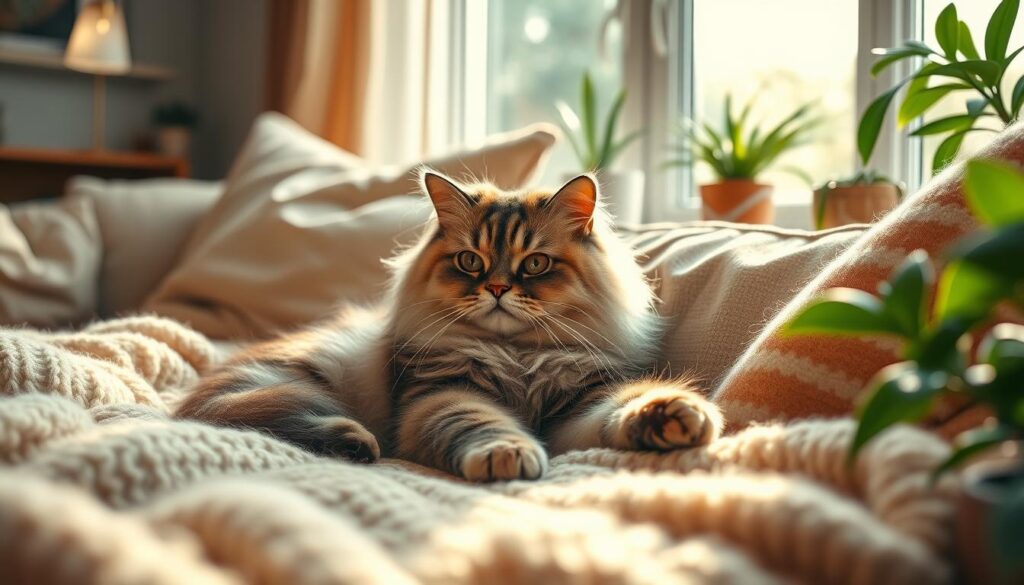
Give your Persian a comfy, cool home with lots to do. This way, they’ll live a long, happy life with you.
Cost of Persian Cat Ownership
Getting a Persian cat is a big deal financially. Purebred kittens cost between $500 and $5,500. The average price is $1,000 to $1,800 from a good breeder. You can adopt one for $100 to $400 from rescue groups.
There are ongoing costs for Persian cats too. Good cat food can cost $28.99 for 3.5 pounds to $56.99 for 11 pounds. Grooming tools and shampoo cost $10 to $20 monthly. Professional grooming can be $100 for short-haired and $120 for long-haired Persians.
Health issues like hypertrophic cardiomyopathy, brachycephalic syndrome, and polycystic kidney disease are common. Tests for HCM can be up to $1,500, with monthly meds at $300. Brachycephalic syndrome treatment costs $200 to $1,500, and polycystic kidney disease averages $649 yearly.
Pet insurance is a good idea to cover these costs. It costs $12 to $46 monthly. Thinking about the costs helps ensure you can give your Persian cat the best care.
| Expense | Cost Range |
|---|---|
| Initial Purchase Price | $500 to $5,500 |
| Breeder Price | $1,000 to $1,800 |
| Adoption Fee | $100 to $400 |
| Grooming Supplies | $10 to $20 per month |
| Professional Grooming | Up to $100 per session for short-haired, up to $120 for long-haired |
| High-Quality Cat Food | $28.99 for a 3.5 lb bag to $56.99 for an 11 lb bag |
| Pet Insurance Premiums | $12 to $46 per month |
| Treating Health Conditions | $5,000 to $20,000 (e.g., heart disease) |
“Owning a Persian cat can be a significant financial commitment, but the rewards of their affectionate nature and regal appearance make them a beloved companion for many cat enthusiasts.”
Choosing a Persian Cat Breeder
Finding a good Persian cat breeder is key when adding a new pet to your family. These cats need special care and a responsible breeder ensures they are healthy and well-socialized. This makes sure they fit well with your lifestyle.
Begin by checking out respected groups like the Cat Fanciers’ Association (CFA) and The International Cat Association (TICA). They list CFA-registered Persian cat breeders who meet high standards for breeding and cat care.
Visit the potential breeders to see where the cats live. A good Persian Cat breeder puts the cats’ health first, keeping their homes clean and providing medical care. This includes genetic tests and health screenings.
Ask the breeder about their experience and qualifications. A reputable breeder will have years of experience, be part of top cat organizations, and have a history of healthy, social kittens.
Adopting an adult Persian cat from a shelter is also a great option. Shelters often have Persians looking for homes, giving a loving home to a cat in need.
| Breeder Qualification | Description |
|---|---|
| CFA Registration | Breeder is registered with the Cat Fanciers’ Association, ensuring adherence to breed standards and ethical practices. |
| Genetic Testing | Breeder conducts comprehensive genetic health screenings, including for Polycystic Kidney Disease (PKD), to produce healthy kittens. |
| Health Guarantees | Breeder offers health and genetic guarantees, providing peace of mind for new owners. |
| Socialization and Care | Breeder prioritizes proper socialization and individual attention for each Persian kitten. |
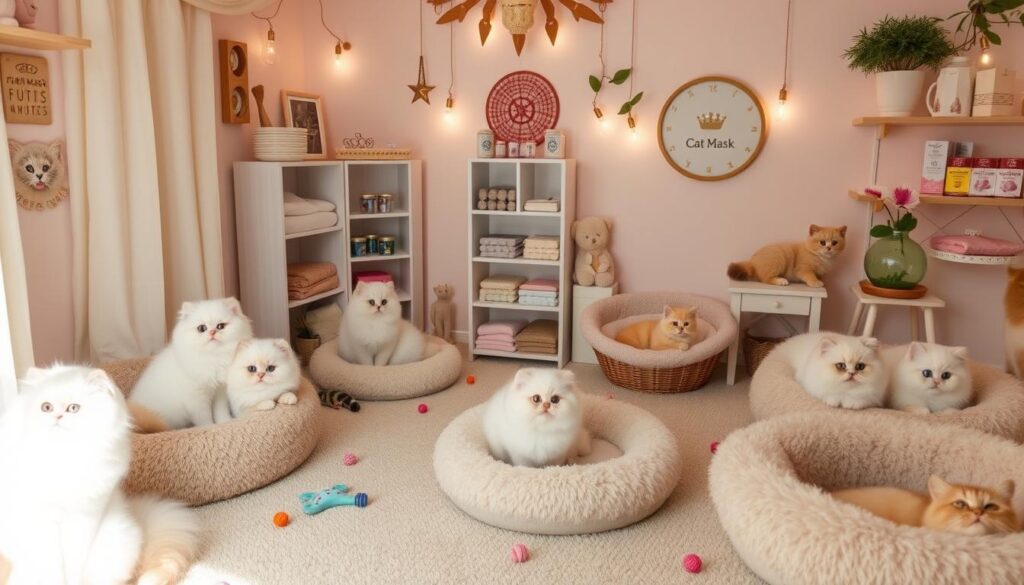
By carefully researching and visiting Persian Cat breeders, you can find a healthy, happy cat. This cat will be a great addition to your home for many years.
Conclusion
The Persian cat is a beloved feline known for its gentle nature and striking appearance. They are very affectionate. These cats need a lot of grooming and have health issues, but many find their company rewarding.
Proper care is key for a happy, healthy Persian cat. This includes regular grooming, health checks, and a good home. It’s important to meet their needs to ensure they live a long, happy life.
Persian cats are popular for their sweet nature and luxurious coats. They love attention and affection from their owners. By understanding their needs, you can give your Persian cat a happy home.
These cats have a special place in many hearts. If you’re interested in a Persian cat, prepare well and care for them. You’ll enjoy their company for many years.
FAQ
What are the key physical characteristics of the Persian cat?
Persian cats are medium to large in size. They have a round, flat face and long, flowing coat. Their legs are short and muscular, with a sturdy body and deep chest.
They have a short muzzle, snub-nose, and round cheeks. Their chin is firm, and their ears are medium-sized. Their eyes are large and round. They come in many colors and patterns, like tabby and tortoiseshell.
What is the temperament and personality of a Persian cat?
Persian cats are sweet, gentle, and calm. They are friendly but need gentle handling. They are good with children and enjoy watching household activities.
They love to be with their family and can get along with other pets. But they also like to have some alone time.
What are the grooming requirements for a Persian cat?
Persian cats need a lot of grooming because of their long coat. They should be brushed daily with a wide-toothed comb and a soft slicker brush. This helps prevent mats.
They also need regular baths and careful drying. Their faces need daily cleaning to avoid tear stains. Nail trimming and ear cleaning are important too. Some owners choose professional grooming or trims like the lion cut.
What are the common health considerations for Persian cats?
Persian cats can get certain health problems. These include hypertrophic cardiomyopathy and trichiasis. They can also have polycystic kidney disease and breathing issues due to their face shape.
Regular vet visits are important for early detection and treatment. Good breeders test adult cats for genetic issues before breeding.
What are the dietary and nutritional needs of a Persian cat?
Persian cats need a balanced diet to stay healthy. They should eat measured meals twice a day, not free feed. Kittens need three meals a day.
Some Persians may have trouble eating because of jaw issues. A vet can suggest the right food for them.
What are the exercise and activity requirements for a Persian cat?
Persian cats need regular play to stay active and mentally sharp. Feather wands and teaser toys are great for this. They also like scratching posts and cat trees.
Interactive toys and puzzle feeders can keep them engaged. Short play sessions a few times a day are enough.
What kind of living environment is suitable for a Persian cat?
Persian cats prefer indoor living and calm environments. They like comfortable spots to rest and watch what’s going on. They don’t need a lot of space but enjoy climbing.
They are sensitive to extreme temperatures, so indoor living is best. They can do well in apartments if they have enough to do and attention.
How much does it cost to own a Persian cat?
Persian cats can be pricey, with breeders charging over $1,000 for a kitten. Ongoing costs include food, grooming, and vet care. Health issues can add to the expenses.
It’s important to consider these costs before getting a Persian cat.
How can I find a responsible Persian cat breeder?
Finding a good Persian cat breeder requires research. Look at lists from the Cat Fanciers’ Association and The International Cat Association. Visit different breeders and check their cats’ living conditions.
Ask about health screenings and genetic testing. You can also consider adopting an adult Persian from a shelter. Good breeders care more about their cats’ health than making money.
,000 for a kitten. Ongoing costs include food, grooming, and vet care. Health issues can add to the expenses.
It’s important to consider these costs before getting a Persian cat.

